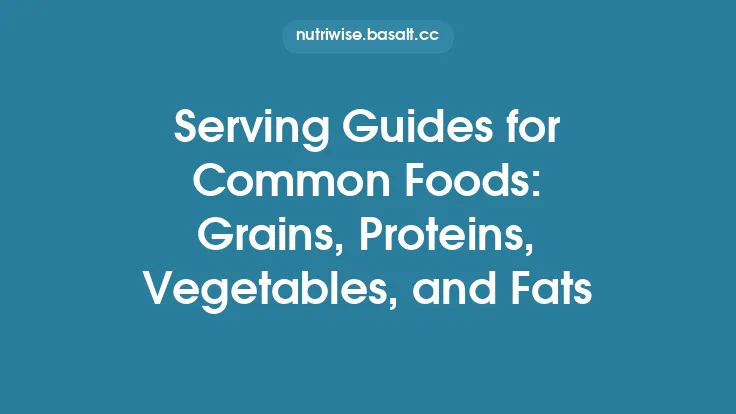When you glance at a nutrition label or a diet‑tracking app, you might see numbers labeled “GI” or “GL.” These figures are more than just academic curiosities; they translate the complex chemistry of carbohydrate digestion into practical guidance for everyday eating. By understanding what the glycemic index (GI) and glycemic load (GL) represent, how they are measured, and how they interact with real‑world food choices, you can fine‑tune meals to support steady energy, better appetite control, and more predictable blood‑sugar responses.
Understanding the Glycemic Index
The glycemic index is a relative ranking system that compares how quickly a carbohydrate‑containing food raises blood glucose after consumption. The reference point is pure glucose (or sometimes white bread), assigned a value of 100. Foods are tested on a group of healthy volunteers who consume a fixed amount of available carbohydrate (usually 50 g) from the test food, and blood glucose is measured at regular intervals over two hours. The area under the glucose response curve (AUC) for the test food is expressed as a percentage of the AUC for the reference.
- Low GI (≤55): Slow, gradual rise in blood glucose.
- Medium GI (56–69): Moderate speed of glucose appearance.
- High GI (≥70): Rapid spike in blood glucose.
Because the GI isolates the carbohydrate component, it does not account for the quantity of carbohydrate actually eaten. A small portion of a high‑GI food may have a modest impact on blood sugar, while a large portion of a low‑GI food could produce a larger overall effect.
From Index to Load: Why Glycemic Load Matters
Glycemic load bridges the gap between quality (GI) and quantity (carbohydrate amount). It is calculated as:
\[
\text{GL} = \frac{\text{GI} \times \text{available carbohydrate (g per serving)}}{100}
\]
GL provides a more realistic estimate of the post‑prandial glucose excursion you can expect from a typical serving. The conventional classification is:
- Low GL (≤10): Minimal impact on blood glucose.
- Medium GL (11–19): Moderate impact.
- High GL (≥20): Significant impact.
For example, watermelon has a GI of about 80 (high), but a typical serving contains only 6 g of available carbohydrate, yielding a GL of roughly 5 (low). Conversely, a cup of cooked white rice (GI ≈ 73) provides about 45 g of carbohydrate, resulting in a GL of ≈33 (high). This distinction helps avoid the “high‑GI = bad” oversimplification.
Key Factors That Influence GI and GL
- Carbohydrate Structure
- Monosaccharides (glucose, fructose) are absorbed rapidly, raising GI.
- Disaccharides (sucrose, lactose) require enzymatic cleavage, slightly slowing absorption.
- Polysaccharides (starch) vary: amylose (linear) digests slower than amylopectin (branched).
- Physical Form and Processing
- Particle size: Fine flours have higher GI than coarser grains.
- Cooking method: Longer cooking gelatinizes starch, increasing GI; al dente pasta retains more resistant starch, lowering GI.
- Food Matrix
- Fat and protein dilute carbohydrate concentration and slow gastric emptying, reducing the glycemic response.
- Acidic components (e.g., vinegar, lemon juice) can lower GI by slowing gastric emptying.
- Fiber Content
- Soluble fiber forms a viscous gel that slows carbohydrate absorption.
- Insoluble fiber adds bulk, reducing the proportion of available carbohydrate per gram of food.
- Ripeness and Storage
- Riper fruits have higher sugar concentrations and more readily digestible starches, raising GI.
- Refrigeration can increase resistant starch in cooked potatoes and rice, lowering GI.
Interpreting Values: What Is Low, Medium, High?
When you encounter a GI or GL figure, place it in context:
| Category | GI Range | GL Range | Typical Examples |
|---|---|---|---|
| Low | ≤55 | ≤10 | Lentils, most non‑starchy vegetables, steel‑cut oats |
| Medium | 56–69 | 11–19 | Brown rice, whole‑wheat bread, pineapple |
| High | ≥70 | ≥20 | White bread, instant oatmeal, baked potatoes |
Remember that the same food can shift categories depending on preparation. For instance, boiled potatoes (GI ≈ 78) become a medium‑GI food when cooled and reheated as a salad, due to retrograded resistant starch formation.
Practical Strategies for Everyday Food Choices
- Prioritize Low‑GI Carbohydrate Sources
- Choose legumes, nuts, seeds, and whole grains with higher amylose content.
- Pair starchy foods with protein or healthy fats (e.g., add avocado to a bean salad).
- Control Portion Size to Manage GL
- Use the “hand” method: a fist‑sized portion of cooked grains or starchy vegetables roughly equals ½ cup (≈15 g carbohydrate).
- For high‑GI foods, keep servings modest (e.g., ¼ cup of cooked white rice).
- Incorporate Acidic Condiments
- A splash of apple cider vinegar or a squeeze of lemon on salads can blunt the glycemic response.
- Leverage Cooking Techniques
- Cook pasta al dente, cool cooked rice or potatoes, then reheat or serve cold to increase resistant starch.
- Opt for steaming or roasting rather than deep‑frying, which adds fat without improving GI.
- Balance Meals with Protein and Fat
- A typical plate: ½ non‑starchy vegetables, ¼ lean protein, ¼ carbohydrate (preferably low‑GI). This distribution naturally moderates glucose spikes.
Meal Planning with GI and GL
Breakfast
- Low‑GI option: Greek yogurt (protein) topped with a handful of berries (low‑GL) and a sprinkle of chia seeds (fat).
- Higher‑GI alternative (controlled GL): Whole‑grain toast (GI ≈ 65) with almond butter; limit to one slice (≈15 g carbohydrate, GL ≈ 10).
Lunch
- Mixed bean salad (black beans GI ≈ 30, GL per ½ cup ≈ 5) with chopped vegetables, olive oil, and a squeeze of citrus.
- Add a small portion of quinoa (GI ≈ 53, GL per ¼ cup ≈ 7) for texture.
Snack
- Apple slices (GI ≈ 38, GL ≈ 6) paired with a few cheese cubes (protein/fat) to slow absorption.
Dinner
- Grilled salmon (protein/fat) with roasted sweet potatoes (GI ≈ 63, GL per ½ cup ≈ 12) and a side of sautéed broccoli (low‑GL).
- Finish with a drizzle of balsamic reduction (acidic) to further moderate the glycemic impact.
By calculating the GL for each component, you can keep the total daily GL within a range that supports stable glucose levels (e.g., 80–120 for most adults, though individual needs vary).
Cooking Techniques and Their Impact
| Technique | Effect on Starch | Resulting GI/GL |
|---|---|---|
| Boiling (soft) | Fully gelatinizes starch, making it readily digestible | ↑ GI |
| Al dente cooking | Partial gelatinization, retains some resistant starch | ↓ GI |
| Cooling & reheating | Retrogradation forms resistant starch | ↓ GI, ↓ GL |
| Microwaving (short bursts) | Minimal structural change if not overcooked | Neutral to slight ↑ GI |
| Fermentation (e.g., sourdough) | Acidic environment pre‑digests starch | ↓ GI |
Applying these methods intentionally can transform a high‑GI staple into a more moderate option without changing the food itself.
Using GI/GL in Special Populations
- People with Diabetes
Monitoring GL helps prevent post‑prandial hyperglycemia. A common recommendation is to keep each meal’s GL below 20 and total daily GL under 100, adjusting for medication and activity level.
- Endurance Athletes
While low‑GI foods support sustained energy, strategic inclusion of high‑GI carbs (e.g., glucose gels) during or immediately after prolonged exercise can expedite glycogen replenishment.
- Weight‑Management Seekers
Low‑GL meals tend to promote satiety because the slower glucose rise delays hunger signals. Pairing low‑GL carbs with protein and fiber further enhances fullness.
Common Pitfalls and Limitations
- Over‑reliance on GI Alone
GI does not reflect portion size; a low‑GI food eaten in excess can still produce a high GL.
- Variability Between Individuals
Genetic factors, gut microbiota composition, and insulin sensitivity can shift personal glycemic responses.
- Testing Conditions vs. Real‑World Meals
Laboratory GI values are derived from isolated foods, not mixed meals. The presence of other macronutrients can significantly alter the actual response.
- Label Inconsistencies
Not all packaged foods list GI or GL; when they do, values may be based on outdated databases.
- Ignoring Micronutrients
Focusing solely on GI/GL may overlook essential vitamins, minerals, and phytochemicals present in higher‑GI foods like certain fruits.
Tools and Resources for Tracking
- Online Databases
The International GI Database (University of Sydney) provides peer‑reviewed GI values for hundreds of foods.
- Mobile Apps
Apps such as “MyFitnessPal” or “Carb Manager” allow you to log foods and view estimated GL based on portion size.
- Portion Guides
Visual cues (e.g., a cupped hand for a serving of rice) help estimate carbohydrate content without a scale.
- Blood Glucose Monitoring
For individuals with diabetes, personal glucose data can validate how specific meals affect their own glycemic response, enabling fine‑tuning beyond generic GI tables.
Putting It All Together: A Sample Day of Balanced Choices
| Meal | Food Items | Approx. GI | Approx. GL |
|---|---|---|---|
| Breakfast | Greek yogurt (0) + ½ cup mixed berries (GI 38) + 1 tbsp chia seeds (0) | 38 | 5 |
| Mid‑Morning Snack | 1 small apple (GI 38) + 10 almonds (0) | 38 | 6 |
| Lunch | Mixed bean salad: ½ cup black beans (GI 30) + ¼ cup quinoa (GI 53) + veggies + olive oil | 30–53 | 5 + 7 = 12 |
| Afternoon Snack | 1 oz cheese (0) + ½ cup cucumber (0) | 0 | 0 |
| Dinner | Grilled salmon (0) + ½ cup roasted sweet potatoes (GI 63) + 1 cup broccoli (GI 15) + balsamic drizzle | 63 | 12 |
| Evening Snack | ¼ cup plain popcorn (GI 55) | 55 | 4 |
Total Daily GL ≈ 44 – comfortably within a low‑to‑moderate range, supporting stable glucose levels while providing a varied nutrient profile.
By integrating the concepts of glycemic index and glycemic load into everyday decision‑making—through mindful food selection, portion control, and cooking methods—you gain a practical toolkit for shaping blood‑sugar responses without sacrificing enjoyment or nutritional adequacy. The approach is flexible: whether you’re aiming for tighter glucose control, sustained energy for training, or simply a more satiating diet, GI and GL offer evergreen, evidence‑based guidance that can be adapted to any lifestyle.





